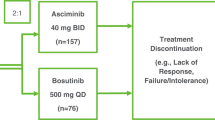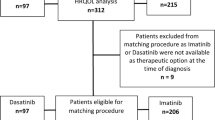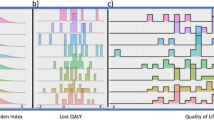Abstract
The objective of this study was to investigate health-related quality of life (HRQOL), symptom burden, and comorbidity profile in long-term acute promyelocytic leukemia (APL) survivors treated with standard chemotherapy. Overall, 307 long-term APL survivors were invited to participate. HRQOL was assessed with the Medical Outcomes Study 36-Item Short-Form Health Survey (SF-36) and compared with that of age and sex-matched controls from the general population. Symptom burden was assessed with the MD Anderson Symptom Inventory (MDASI) questionnaire and comorbidity profile was also investigated. Median follow-up time since diagnosis was 14.3 years (interquartile range: 11.1–16.9 years). APL survivors had a statistically and clinically meaningful worse score for the role physical scale of the SF-36 (−9.5; 95% CI, −15.7 to −3.2, P = 0.003) than their peers in the general population. Fatigue was reported as moderate to severe by 29% of patients and 84.4% reported at least one comorbidity. Prevalence of comorbidity in APL survivors was higher than that reported by the general population. Also, marked variations were found in the HRQOL profile by number of comorbidities. Even many years after treatment ends, APL survivors treated with standard chemotherapy do not fully recover as they report HRQOL limitations and a substantial burden of symptoms.
This is a preview of subscription content, access via your institution
Access options
Subscribe to this journal
Receive 12 print issues and online access
$259.00 per year
only $21.58 per issue
Buy this article
- Purchase on Springer Link
- Instant access to full article PDF
Prices may be subject to local taxes which are calculated during checkout



Similar content being viewed by others
References
Soignet SL, Maslak P, Wang ZG, Jhanwar S, Calleja E, Dardashti LJ, et al. Complete remission after treatment of acute promyelocytic leukemia with arsenic trioxide. N Engl J Med. 1998;339:1341–8.
Sanz MA, Martin G, Gonzalez M, Leon A, Rayon C, Rivas C, et al. Risk-adapted treatment of acute promyelocytic leukemia with all-trans-retinoic acid and anthracycline monochemotherapy: a multicenter study by the PETHEMA group. Blood. 2004;103:1237–43.
Avvisati G, Lo Coco F, Diverio D, Falda M, Ferrara F, Lazzarino M, et al. AIDA (all-trans retinoic acid + idarubicin) in newly diagnosed acute promyelocytic leukemia: a Gruppo Italiano Malattie Ematologiche Maligne dell’Adulto (GIMEMA) pilot study. Blood. 1996;88:1390–8.
Sanz MA, Lo Coco F, Martin G, Avvisati G, Rayon C, Barbui T, et al. Definition of relapse risk and role of nonanthracycline drugs for consolidation in patients with acute promyelocytic leukemia: a joint study of the PETHEMA and GIMEMA cooperative groups. Blood. 2000;96:1247–53.
Sanz MA, Lo-Coco F. Modern approaches to treating acute promyelocytic leukemia. J Clin Oncol. 2011;29:495–503.
Lo-Coco F, Avvisati G, Vignetti M, Breccia M, Gallo E, Rambaldi A, et al. Front-line treatment of acute promyelocytic leukemia with AIDA induction followed by risk-adapted consolidation for adults younger than 61 years: results of the AIDA-2000 trial of the GIMEMA Group. Blood. 2010;116:3171–9.
Sanz MA, Montesinos P, Rayon C, Holowiecka A, de la Serna J, Milone G, et al. Risk-adapted treatment of acute promyelocytic leukemia based on all-trans retinoic acid and anthracycline with addition of cytarabine in consolidation therapy for high-risk patients: further improvements in treatment outcome. Blood. 2010;115:5137–46.
Burnett AK, Russell NH, Hills RK, Bowen D, Kell J, Knapper S, et al. Arsenic trioxide and all-trans retinoic acid treatment for acute promyelocytic leukaemia in all risk groups (AML17): results of a randomised, controlled, phase 3 trial. Lancet Oncol. 2015;16:1295–305.
Lo-Coco F, Avvisati G, Vignetti M, Thiede C, Orlando SM, Iacobelli S, et al. Retinoic acid and arsenic trioxide for acute promyelocytic leukemia. N Engl J Med. 2013;369:111–21.
National Comprehensive Cancer Network (NCCN). Clinical practice guidelines in oncology. Acute Myeloid Leukemia. V.2.2018, August 1, 2018.
Platzbecker U, Avvisati G, Cicconi L, Thiede C, Paoloni F, Vignetti M, et al. Improved outcomes with retinoic acid and arsenic trioxide compared with retinoic acid and chemotherapy in non-high-risk acute promyelocytic leukemia: final results of the randomized Italian–German APL0406 trial. J Clin Oncol. 2017;35:605–12.
Efficace F, Mandelli F, Avvisati G, Cottone F, Ferrara F, Bona ED, et al. Randomized phase III trial of retinoic acid and arsenic trioxide versus retinoic acid and chemotherapy in patients with acute promyelocytic leukemia: health-related quality-of-life outcomes. J Clin Oncol. 2014;32:3406–12.
Chen Y, Kantarjian H, Wang H, Cortes J, Ravandi F. Acute promyelocytic leukemia: a population-based study on incidence and survival in the United States, 1975–2008. Cancer. 2012;118:5811–8.
Efficace F, Mandelli F, Platzbecker U, Cottone F, Lo Coco F. Time to improve health-related quality of life outcomes in patients with acute promyelocytic leukemia. Blood. 2015;126:2523–4.
Harrop JP, Dean JA, Paskett ED. Cancer survivorship research: a review of the literature and summary of current NCI-designated cancer center projects. Cancer Epidemiol Biomark Prev. 2011;20:2042–7.
Abedin S, Altman JK. Acute promyelocytic leukemia: preventing early complications and late toxicities. Hematol Am Soc Hematol Educ Program. 2016;2016:10–5.
Avvisati G, Lo-Coco F, Paoloni FP, Petti MC, Diverio D, Vignetti M, et al. AIDA 0493 protocol for newly diagnosed acute promyelocytic leukemia: very long-term results and role of maintenance. Blood. 2011;117:4716–25.
Ware JE Jr, Sherbourne CD. The MOS 36-item short-form health survey (SF-36). I. Conceptual framework and item selection. Med Care. 1992;30:473–83.
Kent EE, Ambs A, Mitchell SA, Clauser SB, Smith AW, Hays RD. Health-related quality of life in older adult survivors of selected cancers: data from the SEER-MHOS linkage. Cancer. 2015;121:758–65.
Cleeland CS, Mendoza TR, Wang XS, Chou C, Harle MT, Morrissey M, et al. Assessing symptom distress in cancer patients: the M.D. Anderson Symptom Inventory. Cancer. 2000;89:1634–46.
Wang XS, Zhao F, Fisch MJ, O’Mara AM, Cella D, Mendoza TR, et al. Prevalence and characteristics of moderate to severe fatigue: a multicenter study in cancer patients and survivors. Cancer. 2014;120:425–32.
Sangha O, Stucki G, Liang MH, Fossel AH, Katz JN. The Self-Administered Comorbidity Questionnaire: a new method to assess comorbidity for clinical and health services research. Arthritis Rheum. 2003;49:156–63.
Ye F, Moon DH, Carpenter WR, Reeve BB, Usinger DS, Green RL, et al. Comparison of patient report and medical records of comorbidities: results from a population-based cohort of patients with prostate cancer. JAMA Oncol. 2017;3:1035–42.
Baumeister H, Kriston L, Bengel J, Harter M. High agreement of self-report and physician-diagnosed somatic conditions yields limited bias in examining mental-physical comorbidity. J Clin Epidemiol. 2010;63:558–65.
De-loyde KJ, Harrison JD, Durcinoska I, Shepherd HL, Solomon MJ, Young JM. Which information source is best? Concordance between patient report, clinician report and medical records of patient co-morbidity and adjuvant therapy health information. J Eval Clin Pract. 2015;21:339–46.
Apolone G, Mosconi P. The Italian SF-36 Health Survey: translation, validation and norming. J Clin Epidemiol. 1998;51:1025–36.
Cottone F, Efficace F, Apolone G, Collins GS. The added value of propensity score matching when using health-related quality of life reference data. Stat Med. 2013;32:5119–32.
Benjamini Y, Hochberg Y. Controlling the false discovery rate—a practical and powerful approach to multiple testing. J R Stat Soc B Met. 1995;57:289–300.
Schunemann HJ, Guyatt GH. Commentary—goodbye M(C)ID! Hello MID, where do you come from? Health Serv Res. 2005;40:593–7.
Sloan J, Symonds T, Vargas-Chanes D, Fridley B. Practical guidelines for assessing the clinical significance of health-related quality of life changes within clinical trials. Drug Inf J. 2003;37:23–31.
ISTAT. Multiscope survey “Health conditions and use of health services”. 2012–2013.
Pemmaraju N, Kantarjian H, Ravandi F, Nogueras-Gonzalez GM, Huang X, O’Brien S, et al. Patient characteristics and outcomes in adolescents and young adults (AYA) with acute myeloid leukemia (AML). Clin Lymphoma Myeloma Leuk. 2016;16:213–22 e2.
Cohen J. Statistical power analysis for the behavioral sciences. 2nd ed. Hillsdale, NJ: Lawrence Erlbaum Associates; 1988.
Zittoun R, Suciu S, Watson M, Solbu G, Muus P, Mandelli F, et al. Quality of life in patients with acute myelogenous leukemia in prolonged first complete remission after bone marrow transplantation (allogeneic or autologous) or chemotherapy: a cross-sectional study of the EORTC-GIMEMA AML 8A trial. Bone Marrow Transplant. 1997;20:307–15.
Messerer D, Engel J, Hasford J, Schaich M, Ehninger G, Sauerland C, et al. Impact of different post-remission strategies on quality of life in patients with acute myeloid leukemia. Haematologica. 2008;93:826–33.
Leunis A, Redekop WK, Uyl-de Groot CA, Lowenberg B. Impaired health-related quality of life in acute myeloid leukemia survivors: a single-center study. Eur J Haematol. 2014;93:198–206.
Watson M, Buck G, Wheatley K, Homewood JR, Goldstone AH, Rees JK, et al. Adverse impact of bone marrow transplantation on quality of life in acute myeloid leukaemia patients; analysis of the UK Medical Research Council AML 10 Trial. Eur J Cancer. 2004;40:971–8.
Timilshina N, Breunis H, Tomlinson GA, Brandwein JM, Buckstein R, Durbano S, et al. Long-term recovery of quality of life and physical function over three years in adult survivors of acute myeloid leukemia after intensive chemotherapy. Leukemia. 2018; https://doi.org/10.1038/s41375-018-0162-5.
Kurosawa S, Yamaguchi T, Mori T, Kanamori H, Onishi Y, Emi N, et al. Patient-reported quality of life after allogeneic hematopoietic cell transplantation or chemotherapy for acute leukemia. Bone Marrow Transplant. 2015;50:1241–9.
Vissers PA, Thong MS, Pouwer F, Zanders MM, Coebergh JW, van de Poll-Franse LV. The impact of comorbidity on Health-Related Quality of Life among cancer survivors: analyses of data from the PROFILES registry. J Cancer Surv. 2013;7:602–13.
Korszun A, Sarker SJ, Chowdhury K, Clark C, Greaves P, Johnson R, et al. Psychosocial factors associated with impact of cancer in longterm haematological cancer survivors. Br J Haematol. 2014;164:790–803.
Acknowledgements
Part of the analyses reported in this article were based on data provided and licensed free of charge for scientific purposes by the Italian Institute of Statistics (ISTAT). However, ISTAT is not responsible neither for the analyses performed on its data nor for the corresponding results. All analyses, findings, and statements reported in this article are solely attributable to the authors and do not reflect the official policy or position of ISTAT. The authors are also grateful to Dr. Paola Mosconi from the Istituto di Ricerche Farmacologiche Mario Negri (Milan, Italy) for her support in getting access to the SF-36 Italian validation data. AIRC Grant IG15467 to FLC.
Author contributions
Conception and design: FE and FLC. Data analysis and interpretation: all authors. Statistical analysis: FC and FE. Manuscript writing: all authors. Final approval of manuscript: all authors.
Author information
Authors and Affiliations
Corresponding author
Ethics declarations
Conflict of interest
FE: Consultancy (Seattle Genetics, Bristol-Myers Squibb, TEVA, Amgen, Orsenix, Incyte); Research funding (Lundbeck, TEVA and Amgen). GA: Honoraria (Teva, Takeda, Roche, Amgen, Jansen). MB: Honoraria for speaking (Novartis, Incyte, Pfizer, BMS). FLC: Consultancy (Orsenix and TEVA); Speakers Bureau (Novartis). The remaining authors declare that they have no conflict of interest.
Human investigations
The human investigations were performed after approval by a local Human Investigations Committee and in accordance with an assurance filed with and approved by the Department of Health and Human Services, where appropriate.
Additional information
This work was presented in part at the 58th American Society of Hematology (ASH) Annual Meeting in San Diego, CA in December 2016.
Supplementary information
Rights and permissions
About this article
Cite this article
Efficace, F., Breccia, M., Avvisati, G. et al. Health-related quality of life, symptom burden, and comorbidity in long-term survivors of acute promyelocytic leukemia. Leukemia 33, 1598–1607 (2019). https://doi.org/10.1038/s41375-018-0325-4
Received:
Revised:
Accepted:
Published:
Issue Date:
DOI: https://doi.org/10.1038/s41375-018-0325-4
This article is cited by
-
Impairment of vocational activities and financial problems are frequent among German blood cancer survivors
Scientific Reports (2023)
-
Health-related quality of life in pediatric patients with β-thalassemia major after hematopoietic stem cell transplantation
Bone Marrow Transplantation (2022)
-
Factors associated with quality of life of adult patients with acute leukemia and their family caregivers in China: a cross-sectional study
Health and Quality of Life Outcomes (2020)
-
Pain and related complaints in patients with acute leukemia: time for simultaneous care in hemato-oncology
Supportive Care in Cancer (2019)



